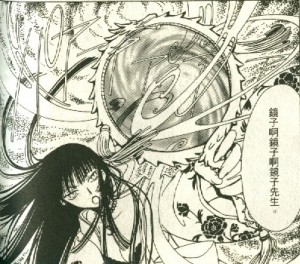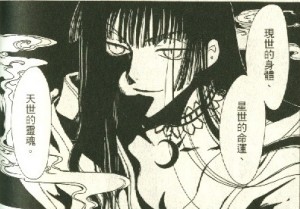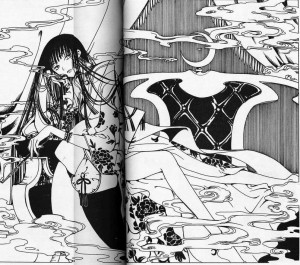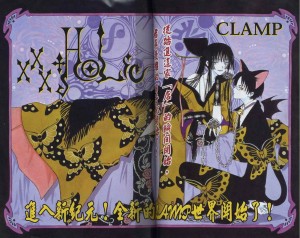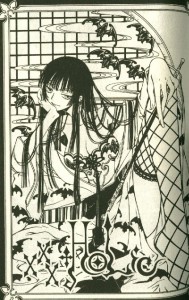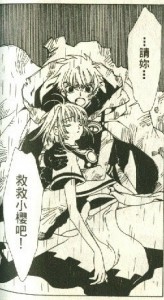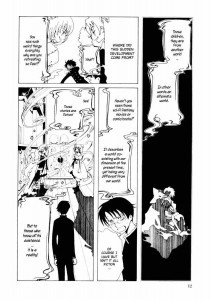The roundtable round-up: Vom Marlowe posts a favorable review, Kinukitty is less kind, Adam Stephanides follows up, Ng Suat Tong goes on the attack, but he also posts examples of Ukiyo-e for comparison.
1. That is a very misleading title.
When you read a title like “xxxHOLiC,” what’s your first thought? Porn addiction!
When Noah first proposed a xxxHOLiC roundtable, I was a little surprised that we were starting off the new year with a discussion of Japanese porn (I don’t know why I was surprised, as this blog is all about the Japanese man-love). But apparently the “xxx” is silent, and the manga is appropriate for teens. That is false advertising.
2. The art is fantastic.
A great deal of manga art leaves me cold. The common style (large eyes, angular features, spiky hair, etc.) doesn’t repulse me, but at the same time I’ve never been drawn to it. This is less an aesthetic judgment than my cultural prejudices, as I grew up reading comics with (relatively) more realistic art.
But strangely, the art in xxxHOLiC appeals to me precisely because it frequently veers further away from realism. The story is set in a universe that’s superficially similar to our own, and the use of the typical manga style for the majority of each chapter reinforces that. But the existence of magic provides a contextual excuse for surreal deviations from the typical. Sometimes these are obvious, as when Yuko is casting a spell.
Other times, the surreal touches can be more subtle, such as Yuko’s cat-like pupils or the heavy use of black.
This panel is reminiscent of a noir-ish crime comic, but the darkness is purely thematic; the other panels on the page establish that the conversation takes place in a well-lit room. In a different context, these artistic flourishes might come across as tedious, but within the world of xxxHOLiC they seem appropriate and are arguably necessary for the story and characters to have the desired effect on the reader.
The surreal elements mix well with the influence of Ukiyo-e, which Vom Marlowe discussed (and Ng Suat Tong generously provided examples of). Yuko frequently lounges about in traditional Japanese (and occasionally Chinese) clothing decorated with intricate patterns.
But while the interior art is impressive, the chapter covers (or whatever they’re called) were the highlight for me. Characters and environment merge, and patterns on costumes shift into the background as aesthetic harmony trumps reality.
3. Add a laugh track and xxxHOLiC would be a sit-com.
The writing left me unimpressed. Other posters have commented on the anticlimaxes, the one-dimensional characters, and the contrivances that are conveniently explained away as “destiny.” When Yuko stated that coincidence does not exist, I was reminded of Star Wars. Enjoyment of the series is dependent on your willingness to just accept that characters will always be in the right place at the right time for the plot to advance. That’s just the way the Force (or hitsuzen) works.
But easily the weakest element of the story was the setup. Sad-sack teenager Kimihiro Watanuki stumbles upon a shop owned by the one woman who can solve his ghost problem. And as payment, he agrees to work for her. Yuko turns him into a maid (but he’s a guy!), and he complains about it, but the two clearly enjoy each others company. And wacky hi-jinks ensue. You can practically hear the creaking of the plot as it gets all the pieces in place.
But the pieces never quite fit. Watanuki’s whining never feels genuine, because he has so little to whine about in this situation. A gorgeous woman wants to spend her day with you, solve your biggest problem, and teach you about magic, and all you have to do in return is some housework? That is not a bad deal. And why does Yuko take so much interest in Watanuki at all? Other than his issue with ghosts, he’s a fairly boring kid, and yet he seems to be at the center of Yuko’s world. Perhaps later volumes will explain her motivations, but I’m not interested enough to find out.
4. Crossovers aren’t just for superheroes anymore.
The crossover with Tsubasa and the references to Cardcaptor Sakura surprised me. I know all those books are produced by CLAMP, but I tend to think of manga as stories operating in self-contained universes, as opposed to the shared universes of American superheroes. Perhaps I’m mistaken, and there are actually a lot of manga crossovers. If anyone wants to list some examples in the comments, I’d appreciate it.
Is it a big deal? I suppose you could characterize the crossover as fairly insubstantial. As far as I can tell, it doesn’t have any long-term consequences on xxxHOLiC, and it only factors significantly in one chapter of volume 2. And while I haven’t read either Cardcaptor Sakura or Tsubasa, I wasn’t confused as to what was going on. We’re still a far cry away from the never-ending, ‘bleed our customers dry’ crossovers that characterize DC and Marvel publishing.
On the other hand, the crossover is more than just a ‘blink and you’ll miss it’ moment. It serves as the climax to volume 1, a way to entice readers, who are presumably fans of Tsubasa and Cardcaptor Sakura, into reading the next volume of xxxHOLiC. And it ties Yuko to the prominent characters of the Tsubasa storyline, leaving the door open for more crossovers in the future.
And then there’s this page, where Yuko explains that the concept of alternate realities to Watanuki.
This explanation could have easily come from a DC comic in the 1960s. In fact, the classic story “Flash of Two Worlds” (1961) first introduced the idea that events in a one world might be recorded as fiction in a parallel world. I would be surprised if the CLAMP creators weren’t at least aware of the DC multiverse.
So what does this mean for CLAMP’s output in the future? Perhaps this crossover is just an aberration. Or maybe CLAMP is prepping its readers for more crossovers. Like the superhero publishers, CLAMP owns several properties that appeal to roughly the same demographic. And given the popularity of crossovers in the U.S., it’s not a stretch to imagine that there are loyal readers in Japan who would be happy to see the characters of various CLAMP titles interact more frequently. Maybe 2010 will be the year of CLAMP United.*
*as dreadful as that sounds, it couldn’t possibly be as bad as that thing Image publishes.
_____________
Update by Noah: You can read all posts in the xxxholic roundtable here.

